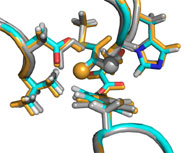Professor Adrian Mulholland in the School of Chemistry and colleagues successfully analyzed why a particular toxic product originating from sodium fluoroacetate (a colourless salt used as a rat poison) is formed in an enzyme.
Professor Mulholland said: “The reaction could go in one of two ways, and only one of those two makes a poison. The difference is very subtle, just in terms of which one of two hydrogen atoms is removed by the enzyme in the reaction.
“This process gives rise to 'lethal synthesis', that is where something non-toxic is converted into a poison in the body. It is responsible for the lethal toxicity of fluoroacetate to humans and other mammals and explains, for example, why plants such as gifblaar in South Africa and Gastrolobium bilobum (heart-leaved poison) in Australia kill sheep and cattle, and why ‘1080’ is such a potent rat poison.”
The Bristol team used high-level quantum mechanics/molecular mechanics (QM/MM) modelling to successfully explain how the enzyme citrate synthase (CS) converts fluoroacetyl-CoA from fluoroacetate to fluoricitrate, which is what makes fluoroacetate toxic. Only the particular form of fluorocitrate made by the enzyme is poisonous; if it made the mirror image molecule instead, the result would not be a poison. The Bristol team’s calculations show why the enzyme produces this form.
CS performs the first reaction in the citric acid cycle, a series of enzyme-catalysed chemical reactions which is of central importance in all living cells. In this reaction, citrate, a six-carbon compound, is formed from a two-carbon acetate in the form of acetyl-CoA and the four-carbon acceptor compound oxaloacetate.
However, if fluoroacetyl-CoA from fluoroacetate is present instead of acetyl-CoA, fluorocitrate is formed. The particular form (isomer) of fluorocitrate, and only this isomer, goes on to react with and inhibit (block) aconitase, the next enzyme in the citric acid cycle. This causes citrate to build-up in tissue and blood, turning off most of the energy supply to cells and resulting in tissue damage and death.
By explaining the conversion of fluoroacetyl-CoA to fluorocitrate by CS, the Bristol research has shed light on an archetypal enzyme selectivity problem. Greater understanding of such problems could assist the prediction of selectivity in enzyme-catalyzed reactions which has potential practical applications in catalyst design and drug metabolism.
The research is published today in Angewandte Chemie, the journal of the German Chemical Society. The study has been classed as a Very Important Paper (VIP) according to the evaluation of three referees; less than 5 percent of manuscripts published by Angewandte Chemie receive such a positive recommendation.
Paper
‘ “Lethal Synthesis” of Fluorocitrate by Citrate Synthase Explained through QM/MM Modeling’ by Marc W. van der Kamp, John D. McGeagh, and Adrian J. Mulholland in Angewandte Chemie
